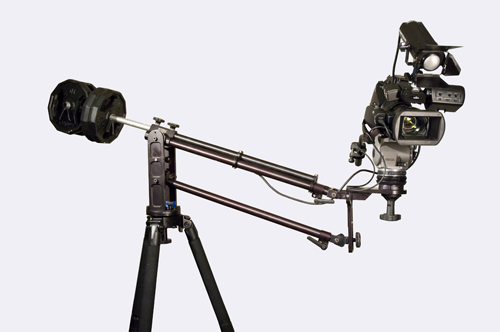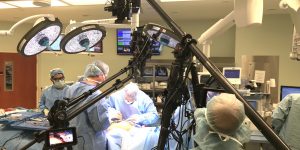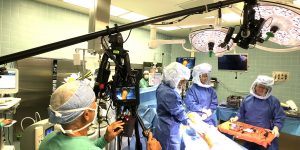Surgical Jib Arms
Shooting surgery shouldn’t even be attempted unless your video crew is using jib or boom arms, so that you can place the cameras and stabilize them high in the sky. You simply won’t get the shots otherwise.

Plexus typically uses two jib arms for most cases. One is a remotely controlled jib with a Sony PMW-EX1 camera that captures the overhead shots, and the other jib is a manually operated jib (pictured above) that is controlled by a camera operator from a slightly less overhead position, enabling that camera to go low or maneuver around a surgeon’s head in a moment’s notice.
Jib Arms Address Patient Safety
Both jibs are designed to keep more distance from the patient and still get the shot. This addresses a patient safety issue that can arise with videographers that enter the OR with nothing more than a camera on a tripod.
When a camera is mounted on a tripod alone the videographer actually has to get closer to the patient, and the likelihood of needing to adjust the tripod for angles is increased. This means the videographer is constantly stirring the air to get their adjustments. With a jib there are no adjustments, only easy movement to the new position quickly. As well, with tripod videography, the surgeon often has to wait for the cameraman to get the shot. But with a manual jib, mostly there is no waiting. Adjustments look natural.
In Praise of Manual Jibs
When the videographer has a keen sense of surgery, the procedure, and what shots are needed, the manual jib arm opens up the possibilities for good surgical videography like no other camera configuration. There is still an important need for a remotely controlled overhead camera, but for the details of a procedure without interrupting the surgeon because the camera has to be repositioned, the manual jib is best. Yet it requires a videographer that knows surgery and the procedure.
In Praise of Overhead Jibs
There are simply certain cases that must be captured with an overhead jib. This is a no-brainer and all surgical videographers think of the overhead jib as a necessity. But few overhead jibs are actually designed for surgery, so for product managers and marketers that hire video crews, make sure their equipment is surgery-ready.
Recently we shot at a hospital that had another video crew come in months before with a monster jib. The crew assembled it in the hall but could not get it through the OR doors. They had to disassemble it and erect it again in the OR. Needless to say, the operating room staff was not happy, and it made the client look bad. It also made it tougher for real surgical videographers in the future as that operating room still felt the pain of that experience.
The reason for camera jib arms in surgery is that they are better at getting the shots than mere camera tripods, and they allow the videographer to keep a distance from the patient at the same time.
Cameras Solutions




